 Submitted by LOGOS - Overseer on
Submitted by LOGOS - Overseer on

Image by MythologyArt from Pixabay
I grew up in the northeast US in an ethnic neighborhood that was predominately Italian and chock full of “the Old Ways.” One of my most outstanding memories was of the neighborhood Strega or witch. As a matter of fact she was the grandmother of family friend. In the Italian community, she was quite revered and depended upon as a counselor as well as the dispenser of useful magick both black and white. I can remember that just about everyone in that community consulted her about everything from love to physical ailments to money to curse removal. A few of the more contemporary neighborhood thinkers wrote most of this off as superstitious nonsense. Yet it was all around me and a way of life. There was no way to ignore it since it was a daily part of the neighborhood buzz and gossip. Of course being just a kid I thought her methodology was just plain weird as I would see her doing some things that I thought at the time were very bizarre from burying “holy” religious statues in the ground under the moonlight to procuring mystery charm bags of strange smelling herbs and spices that were kept faithfully by doorways and other special places. I had even been the accidental recipient of a basin of an oil and water test for the Malocchio (Evil Eye) which rained down on my head after being dumped over the second floor porch railing as I sat on the first floor front steps of our old apartment building. Here is a Malocchio vid! Laugh if you like but it works!
If a person received the Malocchio also known as "overlook" he or she might suddenly and unexplicably become ill usually with a severe headache centered between the eyes and the forehead and terrible fatigue that prevented engagement in daily routine. The cure is as follows:
1. Place three drops of olive oil, one upon the other, in a bowl of water. If the drops remain together, the illness is natural. If the drops separate or smear across the surface of the water, the Malocchio is present! This seemed to be a daily occurrence in my neighborhood.
2. To break the spell, two sewing needles were needed. One needle tip was inserted into the eye of the other needle as the following was said:
"Occhi e contro i perticelli agli occhi." (Eyes against eyes and the holes of the eyes, envy cracks and eyes burst.)
3. The needles were then dropped into the water on top of the oil drops. Next, three pinches of salt were sprinkled into the water. A pair of scissors is jabbed into the water three times through the oil drops. The scissors are removed from the water and the air above the bowl is "cut" three times. The spell is broken.
I remember there were two charms that were believed to prevent the Malocchio, one of which became popular back in the 70s which was a golden horn or a golden hand making the horned signal. Both were often seen worn around the neck or sported proudly as a key ring. But the pièce de résistance was the Camaruta or Cima di Ruta. Cimaruta means “sprig of rue” and the branches of the charm are the branches/blossoms of the rue plant. From the rue branches at each end is a sprout and out of the sprout comes forth symbols such as a key, dagger, blossom, and moon. All Cimaruta are different according to region of origin, and the symbols vary. Some of the variations include: a rose, a hand holding a wand or sword, a flaming heart, a fish, a crescent moon, a snake, an owl, a plumed Medieval helmet, a Vervain flower blossom, a dolphin, a cock, and an eagle. The Cimaruta is traditionally made of silver, and often are double-sided. In folkloric practices the Cimaruta was often placed above the beds of infants, as protection against the "mal'occhio" or evil eye. These charms are fairly large, some almost 4 inches across. They can be worn around the neck and also be hung above any door, on the wall, etc. This type of jewelry is rare and can be very difficult to find.
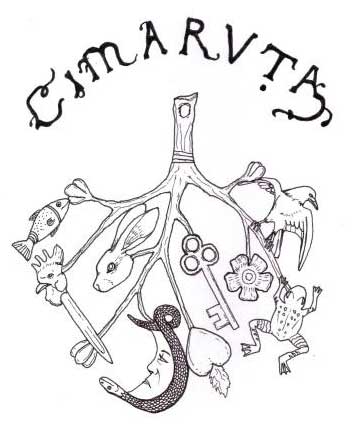
What really used to tickle me about our neighborhood Strega was the fact that some of the men in the community literally feared this woman and to be quite honest, she was very scary looking right down to the long black dress with the high button collar she always wore to the oil lantern she carried while out and about at night. Yet even as a young child, I always thought that her goal was only to help others despite the fact had my doubts that her skills even worked at all ... until my own mother asked her to get rid of a wart that had popped up on my hand. Needless to say – the old strega worked her magick and that wart was gone in a few days without her even touching me or so much as looking at me. Made a believer out of me and left me with much curiosity about just how this whole world of the strega worked. Besides within my “mutt” blended genetics I am part Italian so what could be more apropos?
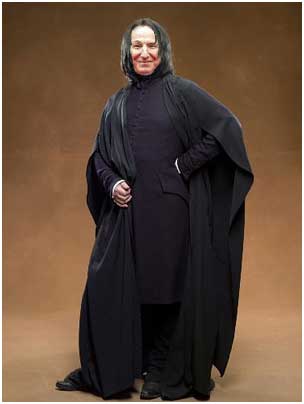
In my research meanderings, it became clear rather quickly that most contemporary writers seem to be unfamiliar with Mediterranean paganism, the Old Religion of Italy and classical witchcraft as it was practiced in ancient Roman times. The more popular focus is on Celtic foundations causing a bypass of the contributions of southern Europe. So let's start with a little bit of background:
Italian of course is a Latin language that uses gender in its word and sentence structure so a female witch is called Strega and a male witch a Stregone. The witches who are practitioners of high magick preferred to be called Maga (female) and Mago (male). The word witchcraft is Stregheria.Witches of the old school and old ways can still be found in Italy today in nearly every village or city. They are great revealers of the old tales of the Lasa (an Italian Elven Race) and of sacred forces behind Nature. The fourteenth century brought about the Church's persecution of witches by in Italy though the focus seemed to be more upon groups and coven than the lone village witch since duties incorporated healing as there was often no medical doctor available and counseling.
Geographically, the witches of central Italy worshiped the goddess Diana and her consort, the god Dianus in the ruins of the sanctuary of Diana at Lake Nemi outside of Rome in the Alban Hills. During the Middle Ages, the site of a sacred walnut tree in the city of Benevento was used to worship the forces of nature personified as gods and goddesses. In northern Italy, in the region of Tuscany descendants of ancient Etruscans still live and preserve the Craft that has been handed down to them through countless generations. The myths of Tuscan Witchcraft concern the old Etruscan gods and the magick and the ceremonies connected to them concern basic Pagan simplicity with very little resemblance to modern practices. One of the more interesting facets of the Tuscan Craft is that the legacy must be passed on to at least one person before a practitioner dies. To fail to do this causes consequences with proper advancement in future lives for a witch is reborn many times growing more powerful with each incarnation.
The magickal focus of the Tuscan witches was mainly on spells, natural objects and omens. Tremendous usage of amulets, charm bags, talismans, and of course plenty of divination and incantations occurred. It must be recognized that Italian Witchcraft like all other types of Witchcraft is rooted in early human development where the "ancestors" believed that a "consciousness" or "spirit" was within ALL things. In Italy this was known as Numen. Since it was the Numen that gave power to all forms in Nature, along with elemental spirits, objects also took on great importance. Ritual circles were seldom used for casting magick or spells and the preference was for "a large flat rock in a field" which was used as a type of altar for power objects. The primary tool of a Tuscan witch was her wand which would be passed over these objects with ritual gestures followed by metered tonal chanting. The traditional deities of the Tuscan Witches are the god Tagni and the goddess Uni who rule over a hierarchy of spirits who exert influence over the Earth. The old religion upheld by the Tuscans relates that the Universe ruled by these deities is comprised of sixteen houses with four of these houses in each of the four quarters...
In the North dwelled the gods of destiny -
In the East dwelled the major gods -
In the South dwelled the astral entities -
In the West dwelled the beings of the Underworld -
Elemental beings called Pala rule the North quarter (considered a place of great power), Air spirits called Bellarie rule the East quarter, Fire spirits called Settiano rule the South quarter and Water spirits called Manii rule the West quarter, along with the Lasa who are spirits connected to the Underworld. These beings are highly important since it is believed that through their interaction vegetation flourishes, the rains fall and the life cycle continues. They are in fact the inner forces of Nature. Some of the other prominent spirits are: Teramo, a messenger spirit; Losna, the spirit of the Moon; Turunna, who governs affairs of the heart; the Fauni and Silvani, spirits of the woods, the Monachetto, gnome-like spirits and the Linchetto who are Elven spirits. These spirits and deities are evoked for a multitude of purposes including cures, rites for attracting love, rites for banishing evil, and acts for "assuring comfort." They are still a part of mundane life in Tuscany more so than in other Craft regions. As with all Crafts, the basic elemental forces are revered and living entities are associated with the magickal properties of the elements.
There are many types of different spirits in Italian folklore. Almost all Strega believe in the Lare (known earlier as the Lasa) who protect the homes and family and preserve the bloodline of the Strega. Lare shrines are often seen set up in the east or west part of the home. The Folletto also known as Basadone (woman kissers) are travellers of the wind and a mischievous lot who take particular interest in sexual situations. The Linchetto, a race of night elves are said to cause nightmares, the Fata are gentle and kind shape-shifters who test human kindness and reward it and the Lauru, another mischievous lot who when treated with respect will reveal "treasure" or even winning lottery numbers.
During the Middle Ages, Italian witchcraft was influenced by Hebrew mysticism (also undergoing persecution) and beginning with the eighteenth century also influenced by Masonary. By the nineteenth century many witches in Italy were Masons and the Masonic influence can be seen in some Strega symbols and rituals. During the 1920s, the infamous Aleister Crowley visited Italy and studied with Italian witches and occultists. In the 1930s, occultist Gerald Gardner learned of Italian witchcraft possibly from Crowley and later spent time investigating the Roman Mystery Cult of Pompeii. Much of what Gardner learned and borrowed from Italian witchcraft is now erroneously attributed to his own original writings.
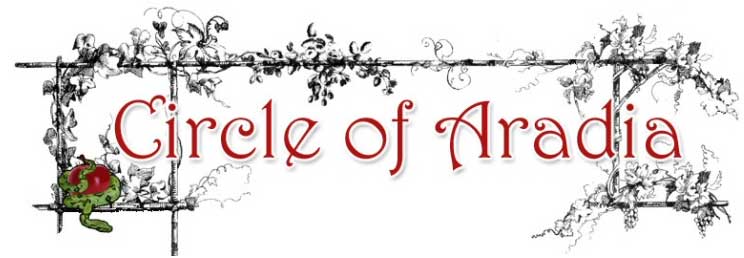
"Then having obtained a pilgrim's dress, she traveled far and wide, teaching and preaching the religion of old times, the religion of Diana, the Queen of the Fairies and of the Moon, the goddess of the poor and oppressed. And the fame of her wisdom and beauty went forth over all the land, and the people worshiped her, calling her La Bella Pelegrina (the beautiful pilgrim)." ~ Charles Leland from Aradia; Gospel of the Witches.
The most famous Italian witch was a fourteenth century wise woman who called herself Aradia. She is responsible for bringing about the revival of an "old religion" - Le Vecchia Religione.
Many Italian witches believe in the historical existence of a woman named Aradia, who brought about a revival of Italian Witchcraft although there is no solid historic proof of her existence has ever been made known to the public. She is often called the Holy Strega or The Beautiful Pilgrim. In the oral traditions surrounding Aradia, residing in the Old Religion of Italy, it is said that she lived and taught during the later half of the 14th century.
According to legend, Aradia was allegedly born in 1313 in northern Italy, in the town of Volterra. She was taught the Old Ways by her aunt and later decided to return the ancient Pagan heritage to the oppressed peasants of Italy. It is said that she would take long walks through the Alban Hill area near Lake Nemi and it was there that she experienced a vision that shaped he course of her life. It is said she heard a voice that told her she was fulfill a quest that would require that she challenge the established order of things in order to provide hope for all those who were enslaved by the wealthy upper class nobility. She gathered a small band of followers and went about the countryside teaching and preaching the Old Religion of Italy. Aradia instructed Italian witches to be naked during rituals and to be sexual with one another as earthy passions strengthen Stregherian rites. Aradia spoke of an Age of Reason that would come, and which would replace the Age of the Son. She stressed the seeking of inner and outer balance and the equality of the masculine and feminine. She challenged the authority of the Church and the so-called rights of nobility to oppress the peasants. She suffered humiliation and torture at the hands of her captors yet never lost sight of her quest. When imprisoned, she used her sexual prowess over men to secure her escape ... never once allowing herself to be a victim. When she departed, Aradia requested that a meal be held in her honor when the Moon was full with gratitude to the goddess Diana, and that she be remembered by future generations. ALL women are daughters of Aradia and her spirit lives on in them.

FESTIVAL OF SEASONS ~ THE EIGHT TREGUENDAS
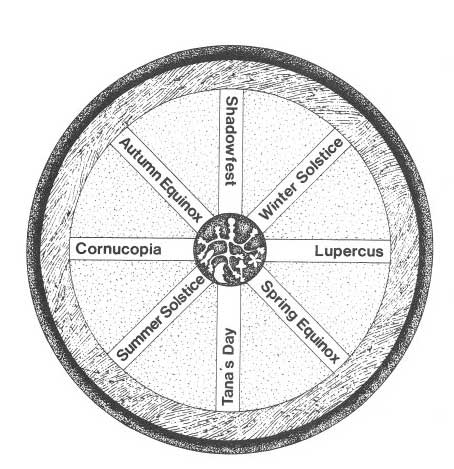
In Italy, the word Sabbat is not used for seasonal rites. The Italian word is Treguenda whjich has its root in the word Tregua meaning "respite" of "truce." The contemporary Italian word Triguenda means "quarterly" so its easy to see the relationship between Sabbat and Treguenda as periods of rest. There are eight Treguendas - four are major and four are minor. The major rites occur in October, February, May and August. The minor rites occur on the Spring and Autumn Equinox and the Summer and Winter Solstice. They are all Earth Festivals that are seasonally agricultural in nature. Many people believe ritual observance of these times are Celtic in origin however, these observances were observed in ancient Roman times in southern Europe.
La Festa dell' Ombra - Shadow Fest: October 31 ... A celebration of Pro-Creation
La Fest dell' Inverno - Winter Solstice: December 21/22 ... The birth of the Sun god from the Union in Shadow Fest. A celebration of light, hope and promise.
Festa di Lupercus -Lupercus: Februray 2 ... Celebration of purification and the beginning of fertility. The puberty of the Sun god.
Equinozio della Primavera - Spring Equinox: March 21/22 ... Celebration of the ascent of the goddess from the Underworld Realm of Shadows and awakening fertility.
La Giornata di Tana - Tana's Day: May 1 ... Celebration of the return of the goddess to the world and of life and the fullness of fertility.
La Fests dell' Estate - Summer Solstice: June 21/22 ...Marriage of the god and goddess and a celebration of life and growth.
La Festa di Cornucopia - Cornucopia: August Eve ... Celebration of plenty and harvest. The god is preparing to sacrifice himself for the world to continue.
Equinozio di Autunno - Autumn Equinox: September 21/22 ... Celebration of Harvest. The god dies and departs to the Underworld and the goddess descends to seek her lost lover.
The Tools and Symbols of Stregheria
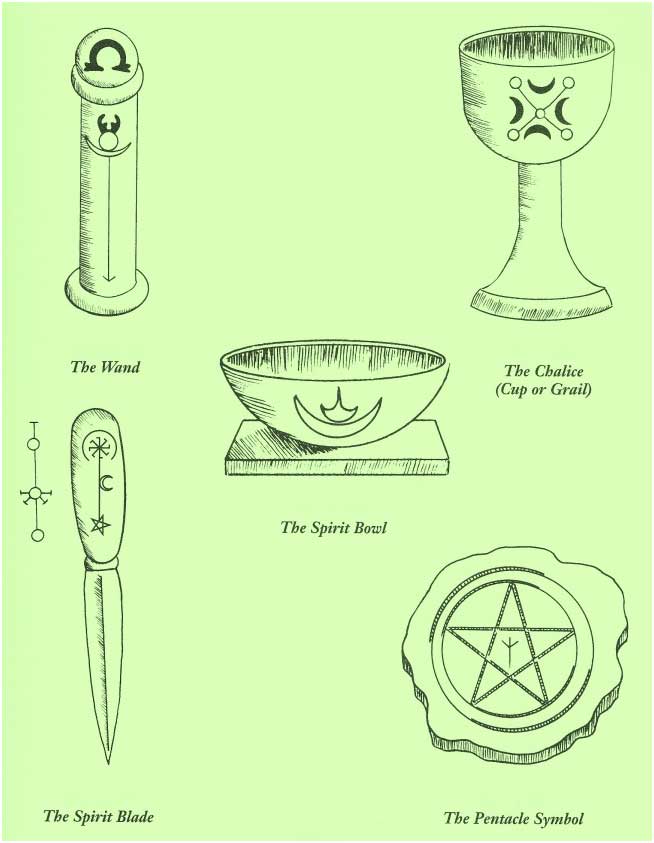
The WAND is made from the branch of a fruit bearing tree although Oak or Willow is also acceptable. When the desired tree is chosen, an offering is poured or placed before the tree before sunrise. The spirit of the tree, its numen must be respectfully addressed with a disclosure of plans. Unless it is felt that the tree spirit rejects these plans, a branch should be secured quickly and wrapped in a cloth and taken home. The branch should be trimmed and all the bark removed. The tip should be fashioned into a smooth phallus shape. The wood must be allowed to dry for nine days before carving or painting any symbols on it. Carving and/or painting is only done on the night of a Full Moon. The wand is then presented to the east quarter and declared to be a wand of magick with power over the element of air. At midnight with the wand pointing at the Full Moon the following must be said:
My Lady, Mistress of the Night and of Magick,
You who rule the star-filled heavens,
bless and empower this wans,
that all may see, and know Thy Greatness.
Wherefore, do I consecrate and dedicate this Wand
to you, Great Mistress of Magick.
Upon completion, set a bowl out beneath the Moon. Put equal portions of the following in the bowl - pennyroyal, rosemary, hyssop and acacia. Poor boiling water into the bowl and steep all ingredients for three minutes. The mixture should then be strained through cheesecloth and the strained liquid then added to a half filled bowl of spring water. Nine drops of almond extract is them added followed by three Moonflowers or white jasmine. Raise the wand up to the Moon once again and then lower it into the bowl. Let the wand sit in its bath for a while then remove it and dry it. It is now ready to use.
The BOWL was originally large shell so either can be used. If a bowl is used a seashell can be placed in the bowl or shells can be placed around the bowl forming a crescent shape to represent the power of the Moon. In the old days, seawater was poured in the bowl but in contemporary clans an alchoholic liquid such as Strega Liquore is used and lighted in a ceramic bowl (minus the seashell). The bowl is placed in the center of the an altar and once a flame has been established it is considered to be the presence of Deity for the ritual. The bowl symbolizes a state of existence between matter and spirit.
The CHALICE, CUP or GRAIL has "womb" associations and is a vessel of transformation and carries essence of the Divine from which all are nourished. The Chalice serves as a connection to the source of our existence on Earth as does the BOWL.
The SPIRIT BLADE is probably one of the most common tools of the Craft. In other ethic Crafts is called an athame. There are old rituals and new rituals for blade preparation. The ritual presented here is from the Nemaic System of Witchcraft created by Raven Grimassi.
Three nights before the Full Moon dig a small hole in the earth which is as deep as your hand is long. Take equal portions (about a handful) of ground herbs - rue, vervain and fennel and add them to the soil you dug out of the hole. Mix it all together and put the soil and mixture back into the hole. Leave this until the night of the Full Moon. On that night, boil about 8 ounces of water and add three pinches of salt. Pour the boiled water out slowly on the ares where the hole was dug. Next mark out a triangle around the hole. Place nine drops of liquid camphor directly upon the center of the hole. Grasp the dagger with both hands pointing the blade down. Raise your arms up to the Moon still holding the dagger which is pointing downward saying:
O Great Goddess Tana, bless me with Power:
Push the blade down into the soil (directly centered in the hole) up to the handle base. Kneel before the Moon, hands on your thighs and say:
At will, I make swift streams retire
To their fountains, whilst their banks admire;
Sea toss and smooth; clear clouds with clouds deform.
With spells and charms I break the viper's jaw,
Cleave solid rocks, oaks from their seizures draw,
Whole woods remove, the lofty mountain shake,
Earth for to groan, and ghosts from graves awake,
And Thee, O Moon, I draw ...
As the last verse is recited, raise your left hand and "cup" the Moon, then quickly close your hand in a grasping manner, seemingly closing the Moon within your hand. Do not look up but bring your closed hand down and grasp the knife handle. Place your right hand firmly over your left and concentrate upon the knife and imagine it glowing with power. After a few minutes, remove the knife from the soil and clean it with a white cloth. The knife is now ready for symbols to be placed on the handle and to be charged with the four elements and dedicated to the service of Tana.
The PENTACLE in its original form was a flat rock used to mark the center of a "sacred space." Later the rock was engraved with etchings to denote the four cardinal points comprising this space. Since the ancients believed the rock contained a spirit the resulting pentacle represented the four elements of creation held in balance by the spirit of Nature. Later pentacles were made from sacred woods associated with deities. The pentacle can be made from any substance and bears a pentagram on its surface. The pentacle does not require any special preparation once the pentagram has been set upon it but a general blessing and anointing with the names of the gods and goddesses seems to be more empowering.
Secondary tools include a Nanta bag (carrier for tools and enforcer of harmony with Nature), broom (protection and banishment), scissors (spell breakers and server of magickal and astral connections), cauldron (offerings) and Lare House or Lasa Shrine (for celebrations of birthdays, marriages and any other event that calls for the lighting of votive candles).
Stregheria Synbols

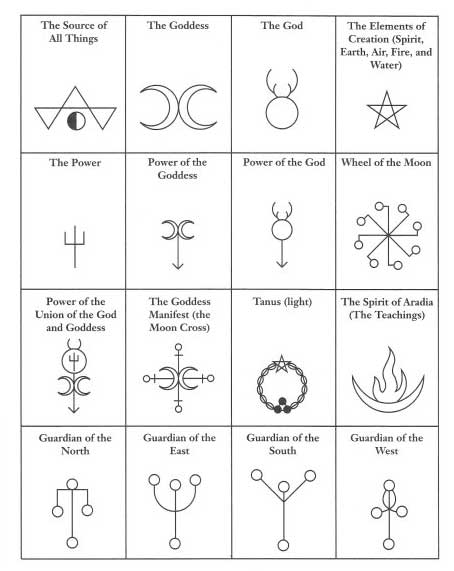
Many similarities can be drawn between Stregheria and other Pagan rites, tools and seasonal/celebration dates. I have barely scratched the surface here but hope I have sparked some interest. If I had it to do all over again, I definitely would have asked more questions and maybe would have even taken a few magick lessons from our old neighborhood Strega ... yet I guess it is never too late to show some appreciation to what has gone before!
Bright blessings - meet you under the Full Moon!